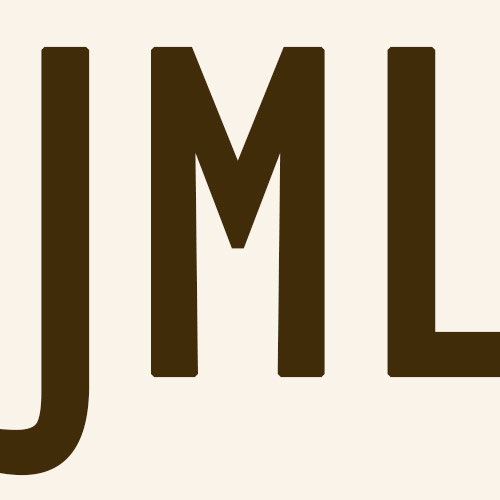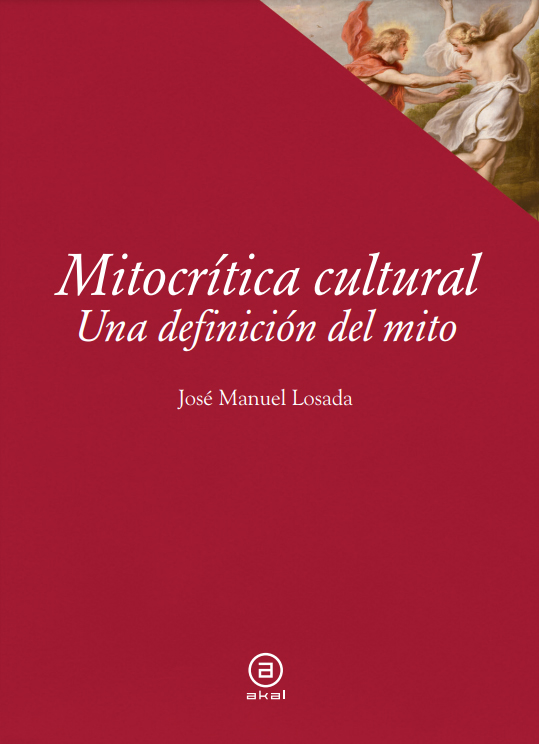Books
Mito: teorías de un concepto controvertido, José Manuel Losada y Antonella Lipscomb (eds.), Madrid, Sial Pigmalión, 2024, 131 pp. ISBN 978-84-19928-03-0.
Awarded with the International Prize of Thought and Essay “Aristotle” 2023.
Presentation: Complutense University (28/02/2024).
― El Diario de Madrid (07/02/2024).
― Mi Ciudad Real (08/02/2024).
― La Opinión de Zamora (14/02/2024).
Mitocrítica cultural: Una definición del mito, José Manuel Losada, Madrid, Ediciones Akal, 2022, 832 pages. ISBN: 978-84-46-05267-8.
Summary
This first omnicomprehensive theory of myth provides a methodology, a hermeneutics, and an epistemology: it gives clear guidelines to locate the myth in any mythical story, proposes heuristic keys for its objective interpretation, and provides myth criticism with a solid basis to claim itself as an autonomous science.
Presentations:
― Universidad Complutense (27/10/2022).
― Librería Berlín (Valencia, 18/05/2023).
― Librería Inusual (Granada, 25/05/2023).
― Biblioteca de Filosofía y Letras (Universidad de Granada, 26/05/2023).
― Ámbito Cultural de El Corte Inglés (Badajoz, 20/10/2023); reseña en Infoprovincia.
Reviews:
― Actio Nova. Revista de Teoría de la Literatura y Literatura Comparada, 7 (2023), pp. xxviii-xxxii (ISSN 2530-4437, https://doi.org/10.15366/actionova2023.7), Isabel González Gil.
― Amaltea. Revista de Mitocrítica, 15 (2023), pp. 1-3 (ISSN-e: 1989-1709, https://dx.doi.org/10.5209/amal.87547), Roxana Martínez Nieto.
― Bajo Palabra. Revista de Filosofía, 34 (2023), época II, pp. 489-492 (e-ISSN: 1887-505X, https://doi.org/10.15366/bp2023.34), Jon Mentxakatorre Odriozola.
― Castilla. Estudios de Literatura, 15 (2024), pp. 854-857 (https://doi.org/10.24197/cel.15.2024.854-857), Carolina López Fic.
― Çédille. Revista de Estudios Franceses, 24 (2003), pp. 595-599 (ISSN 1699-4949, https://doi.org/10.25145/j.cedille.2023.24.31), Adriana Lastičová.
― CompLit. Journal of European Literature, Arts and Society, 7 (2024), 1, pp. 211-215, Mythical Narratives in Comparative European Literature / Le récit mythique dans la littérature européenne comparée, José Luis Miras.
― Cuadernos de Filología Clásica. Estudios griegos e indoeuropeos, 34 (2024), pp. 273-274 (ISSN 1131-9070), https://dx.doi.org/10.5209/cfcg.94474, Óscar Martínez García.
― Dicenda. Estudios de lengua y literatura españolas, 41 (2023), pp. 261-263 (ISSN-e 1988-2556, http://dx.doi.org/10.5209/dice.91637), Mehmet Ilgürel.
― Estudios Clásicos (Sociedad Española de Estudios Clásicos), 164 (2023), pp. (e-ISSN: 2445-0537, https://doi.org/10.48232/eclas.164.17), Begoña Cadiñanos Martínez.
― Europe and Orient. Journal of Historical and Cultural Interactions, 1/2023, pp. 139-142 (ISSN 2815-4894), José Manuel Correoso.
― Hypercultura (Hyperion University, Rumanía), 12/2023, pp. 2-5 (ISSN 2559-2025), Jaime Segura San Miguel.
― Ἰlu. Revista de Ciencias de las Religiones (ISSN-e: 2174-5218), 28 (2023), pp. 1-2 (https://dx.doi.org/10.5209/ilur.86808, e-ISSN: 1988-3269), Enrique Santos Marinas.
― La Razón (“El poder del mito”), 04/01/2023, David Hernández de la Fuente.
― Man of Bronze, 19/12/2022, Pedro Angosto.
― Revista de Literatura, 85, 170 (2023), pp. 699-719 (ISSN: 0034-849X), Xiana Sotelo.
― RILCE. Revista de Filología Hispánica, 39.2 (2023), pp. 801-804 (ISSN-e: 2174-0917, https://doi.org/10.15581/008.39.2.801), María Flores-Fernández.
― Tropelías. Revista de Teoría de la Literatura y Literatura Comparada, 41 (2024), pp. 189-190 (ISSN-e 2255-5463), María del Carmen Lechosa.
Interviews:
― Revista de Letras, Berta Ares, 22/10/2022.
― Radio Intereconomía (“El marcapáginas”), David Felipe Arranz, 29/11/2022.
― Medievo (Twitch), Santiago Ramos García, 18/02/2023.
― El Cultural (“Es el mito, estúpido”, El Español), 20/09/2023, Berta Ares.
― El Debate, Adrián González, 01/03/2023.
― El Confidencial (“Alma, corazón y vida”), Ada Nuño, 23/06/2023. Traducida, con introducción original, por Brikena Smajli, en Exlibris, n.º 243, Albania (29/07/2023).
― La Opinión de Zamora, 04/02/2023, Beatriz Blanco García.
“Presentation at the Complutense University” (27/10/2022)


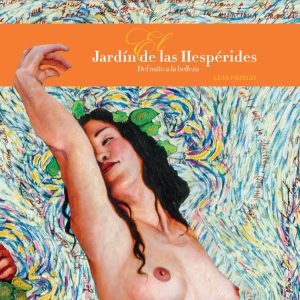

El Jardín de las Hespérides: del mito a la belleza, José Manuel Losada (ed.), Catálogo de la Exposición de Luis Priego en el c arte c (Centro de Arte Complutense), Madrid, Ediciones Complutense, 2022, 111 pp. ISBN: 978-84-09-36855-6.
Summary
The catalogue (111 color pages) includes all the works from the exhibition of oil paintings by the painter Luis Priego, displayed at c arte c (Centro de Arte Complutense), Madrid, from January 20 to April 4, 2022. It also includes texts by various personalities, as well as a Prologue by the exhibition’s curator, José Manuel Losada.


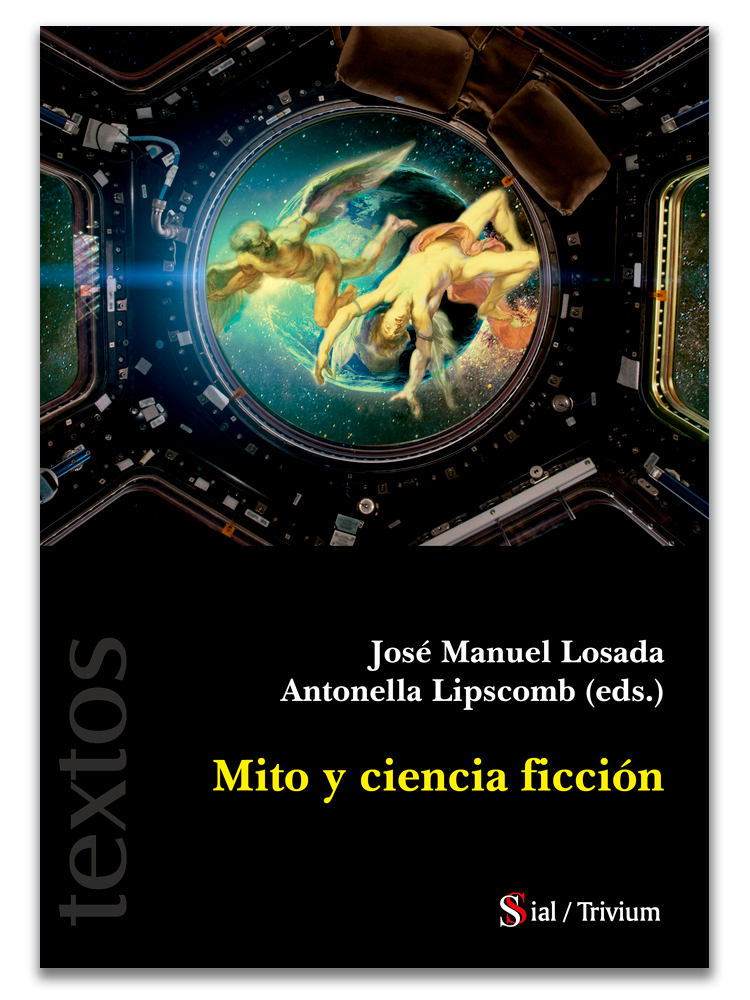

Mito y ciencia ficción, José Manuel Losada & Antonella Lipscomb (eds.), Madrid (España), Sial Pigmalión, 2021, 143 p. ISBN: 978-84-18888-12-0.
Summary
Myth and science fiction seek to explain the world, to answer everlasting questions: the origin of life and cause of death. But explanations are not sufficient for mankind: one wants to make approving or condemning judgements. Myth as well as science fiction project contradictions in unprecedented circumstances with an aim to adhere or condemn. Given the
projective capacity of our imagination, we put forward improbable scenarios that allow us to see in a new light the consequences of a future situation.


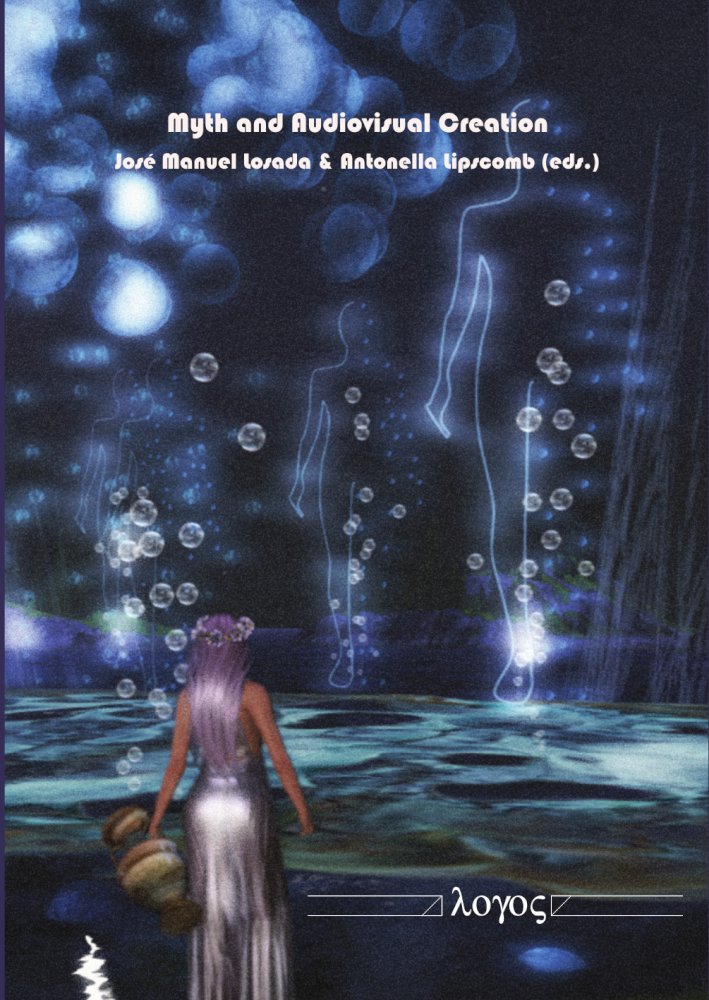

Myth and Audiovisual Creation, José Manuel Losada & Antonella Lipscomb (eds.), Berlin (Germany), Logos Verlag, 2019, 224 p. ISBN: 978-3-8325-4966-4.
Summary
Our aim is to understand if myth has been directly affected by the digital revolution and to what extent it has retained its original essence or whether it has mutated to new forms.
These articles tackle films and television series that devote a considerable part to the impact of transcendence in our lives. They show that myth continues to be a particularly suitable tool for the knowledge of our society and of ourselves.
https://www.logos-verlag.de/cgi-bin/engbuchmid?isbn=4966&lng=deu&id=


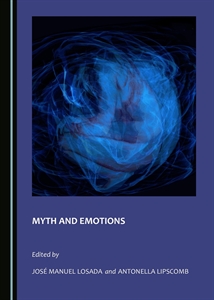

Myth and Emotions, edited by José Manuel Losada & Antonella Lipscomb, Newcastle upon Tyne (United Kingdom), Cambridge Scholars Publishing, 2017, xviii-345 p. ISBN: 978-1-5275-0011-2.7.
Summary
The emotive nature of myth lays the foundation of the research proposed for this trilingual volume. The book aims to provide a study, as wide and thorough as possible, that brings guidelines and models capable of interpreting the mythical-emotional phenomena. Its implementation will be of great help to understand an important part of the writing and art of modernity and post-modernity, as well as cultures and thought of our current society.
http://www.cambridgescholars.com/myth-and-emotions
https://www.academia.edu/35427330/Myth_and_Emotions
Reviews
― Amaltea. Revista de Mitocrítica (Madrid), 10, 2018, p. 129-131, Esther Bautista Naranjo.
http://revistas.ucm.es/index.php/AMAL/article/view/61015/4564456547727
http://dx.doi.org/10.5209/AMAL.61015
― “Mitokritika in sodobna literarna veda”, Primerjalna književnost (Ljubljana, Slovenija), 41, 3, 2018, p. 59-76, Metka Zupančič (vid. p. 70-73).
https://ojs.zrc-sazu.si/primerjalna_knjizevnost/article/view/7149/6669


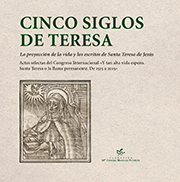

Cinco siglos de Teresa. La proyección de la vida y los escritos de Santa Teresa de Jesús. Actas selectas del Congreso Internacional “Y tan alta vida espero. Santa Teresa o la llama permanente. De 1515 a 2015”, Esther Borrego and José Manuel Losada eds., Madrid, Fundación Mª Cristina Masaveu Peterson, 2016, 366 p. ISBN: 978-84-617-7170-7.
Review
― Atrio. Revista de Historia del Arte (Sevilla), 23, 2017, p. 172-174, Celia Redondo Blasco.
https://www.upo.es/revistas/index.php/atrio/article/view/3774/2992


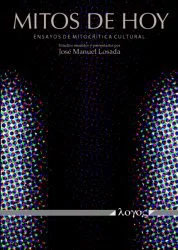

Mitos de hoy. Ensayos de mitocrítica cultural, estudios reunidos y presentados por José Manuel Losada, Berlin, Logos Verlag, 2016, 211 p. ISBN: 978-3-8325-4239-9.
Summary
Cultural Myth Criticism, the new proposal that it is offered here, combines traditional tools of myth criticism with factors not systematically considered by previous criticism: globalization,
Reviews
― Journal of Comparative Literature and Aesthetics (Odisha, India), 29, 1-2, 2016, p. 143-145, Manuel Botero Camacho.
― ’Ilu. Revista de Ciencias de las Religiones (Madrid), 21, 2016, p. 271-273, Borja Cano Vidal.
http://dx.doi. org/10.5209/ILUR.53862
http://revistas.ucm.es/index.php/ILUR/article/view/53862/49306
― Cuadernos de Información y Comunicación (Madrid), 22, 2017, p. 319-320, Esther Bautista Naranjo. http://dx.doi.org/10.5209/CIYC.55986 http://revistas.ucm.es/index.php/CIYC/article/view/55986/50718
― Amaltea, Revista de Mitocrítica (Madrid), 9, 2017, p. 87-89, Cristina Salcedo González.
http://revistas.ucm.es/index.php/AMAL/article/view/57182/51581
http://dx.doi.org/10.5209/AMAL.57182
― Minerva, Revista de Filología Clásica (Valladolid), 31, 2018, p. 291-294, Carlos Sánchez Pérez.
https://doi.org/10.24197/mrfc.31.2018.291-294
https://revistas.uva.es/index.php/minerva/article/view/1161
― “Mitokritika in sodobna literarna veda”, Primerjalna književnost (Ljubljana, Slovenija), 41, 3, 2018, p. 59-76, Metka Zupančič (vid. p. 70-73).
https://ojs.zrc-sazu.si/primerjalna_knjizevnost/article/view/7149/6669




Myths in Crisis: The Crisis of Myth, Newcastle upon Tyne, Cambridge Scholars Publishing, 2015, xxix-441 p. ISBN: 978-1-4438-7814-2.
Summary
This trilingual volume examines the extent to which myths are affected by the crisis of the 20th and 21st centuries.
Four theoretical studies analize both the crisis of structure ―that imply the distortion or disappearance of myth― and the crisis of concept and terminology, that currently threaten the study of mythology.
The largest section of the volume focuses on the crisis that affect ancient, medieval and modern literary myths from a global perspective: psychology, ethics, politics and contemporary meta-literature.
The final section of the volume examines the crisis experienced by the myths of the immanence: historical and fictitious characters, mythologized places and language.
Reviews
― Journal of Comparative Literature and Aesthetics (Odisha, India), xxxix, 1-2, 2016, p. 145-149, Juan González Etxeberria.
― Revista de Literatura (Madrid), lxxix, 158, 2017, p. 625-627, Borja Cano Vidal.
http://revistadeliteratura.revistas.csic.es/index.php/revistadeliteratura/article/view/431/446
― “Mitokritika in sodobna literarna veda”, Primerjalna književnost (Ljubljana, Slovenija), 41, 3, 2018, p. 59-76, Metka Zupančič (vid. p. 70-73).
https://ojs.zrc-sazu.si/primerjalna_knjizevnost/article/view/7149/6669


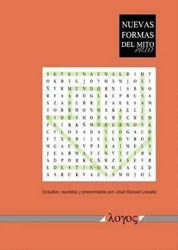

Nuevas formas del mito. Una metodología interdisciplinar, Berlin, Logos Verlag, 2015, 221 p. ISBN: 978-3-8325-4040-1.
Summary
Myth: explicative, symbolic and dynamic tale that recounts one or more extraordinary events —which are personal and transcendental; it lacks historical testimony and is made up of invariable thematic elements, which are often presented in a situation of crisis; presents a conflictive, emotive, functional and ritual character, and always points out towards an absolute cosmogony or eschatology, which may be particular or universal.
This definition, general, cold and indeterminate, requires a time, a space and especially a consciousness to come to life. Myth is not a mental construct unconnected to sociocultural vicissitudes: it bears —on its skin and in its entrails— the mark of each individual and of each society. Myth is a slave longing to be set free: in the same way it cannot be rid of its inherited form and content, it also cannot keep from dreaming of new forms and contents —the promise of an improbable liberation.
New Forms of Myth depicts those forms and those contents in a new time and in a place. The novelty of the method lies in vindicating the coalescence of the traditional procedures of myth-criticism and new aspects that have not been systematically analysed yet by scholarly research, namely: globalization, immanence and consumerism. The book thus offers a modest contribution to the task of identifying, analysing and synthetizing the typology of myth in literature, fine arts and contemporary media. Hopefully, this will lead to a better understanding of our own consciousness in this disconcerting world.
Table of Contents and Introductory Chapter
Reviews
― Çédille. Revista de Estudios Franceses, “Los retos de la mitocrítica ante las nuevas formas del mundo en el mundo globalizado”, 12, abril de 2016, p. 521-526, Tagirem Gallego García.
http:// cedille.webs.ull.es/12/29gallego.pdf
― ’Ilu. Revista de Ciencias de las Religiones (Madrid), 21, 2016, p. 268-270, Borja Cano Vidal.
http://revistas.ucm.es/index.php/ILUR/article/view/53862 y http://dx.doi.org/ 10.5209/ILUR.53861
― Bajo Palabra. Revista de Filosofía (Madrid), II Época, 12, 2016, p. 413-415, Helena González-Vaquerizo.
https://repositorio.uam.es/handle/10486/675044
― Amaltea. Revista de Mitocrítica (Madrid), 8, 2016, p. 69-74, Luis Alberto Pérez Amezcua.
http://dx. doi.org/10.5209/AMAL.53424
http://revistas.ucm.es/index.php/AMAL/article/view/53424/49004
― Thélème. Revista Complutense de Estudios Franceses (Madrid), 31, 2, 2016, p. 345-347, José Carlos Marco Vega. http://dx.doi.org/10.5209/THEL.54097
https://revistas.ucm.es/index.php/THEL/article/view/ 54097/49486
― Minerva. Revista de Filología Clásica (Valladolid), 30 (2017), p. 367-370, Adrián Menéndez de la Cuesta.
https://revistas.uva.es/index.php/minerva/article/view/1180
https://doi.org/10.24197/mrfc.30.2017.367-370
― “Mitokritika in sodobna literarna veda”, Primerjalna književnost (Ljubljana, Slovenija), 41, 3, 2018, p. 59-76, Metka Zupančič (vid. p. 70-73).
https://ojs.zrc-sazu.si/primerjalna_knjizevnost/article/view/7149/6669




Victor Hugo et l’Espagne. L’imaginaire hispanique dans l’œuvre poétique. Avec la collaboration d’André Labertit, Paris, Honoré Champion, 2014, 560 p. ISBN: 978-2-7453-2698-0
Summary
Victor Hugo’s stay in Madrid as a child, the journey to the Spanish Basque Country and Navarre as an adult, his Spanish readings in the original or in translation, have left deep traces in him. This book collects and analyzes them throughout his poetic work reviewed in its entirety. With a major innovation: beyond the collection and identification of the data, this study addresses the evaluation of Spain in Hugo’s poetic universe. Weighed and placed in the path of his production, this Spanish influence comes to get significance and uniqueness both in Hugo as in the perspective of the French romantic movement.
Reviews
― L’Écho Hugo (París), 13, 2014, p. 30-31, Arnaud Laster.
― Fabula. L’Information en Littérature (París), 1 julio 2014, Perrine Coudurier.
http:// www.fabula.org/actualites/jose-manuel-losada-goya-victor-hugo-et-l-espagne-l-imagin aire-hispanique-dans-l-oeuvre-poetique_63733.php
― Revue de Littérature Comparée (París), 355, 2015, p. 345-346, Véronique Gély.
― Revue d’Histoire Littéraire de la France (París), 115, 1, marzo 2015, p. 210-211, Michel Garcia.
https://www.cairn.info/revue-d-histoire-litteraire-de-la-france-2015-1-page-191.htm
― Studi Francesi (Turín), 179 (LX-II), 2016, p. 346-347, Jean-Marc Hovasse.


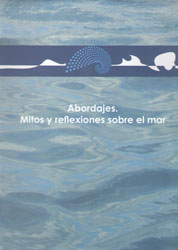

Abordajes. Mitos y reflexiones sobre el mar, dir. José Manuel Losada, Madrid, Instituto Español de Oceanografía, 2014, 274 p., 95 ilustr. ISBN: 978-84-95877-51-2.
Summary
This is the aim of the present study: to account for what the sea has represented and represents for us today. This focus explains the title, “boarding” in a metaphorical sense: encounters between ships transporting different cargos, all aboard—prow, poop, port, or starboard, all charges allowed—to obtain whatever the sea can give us. The sea transformed into a school, a form of learning. The point is to research a new side of the sea: the unaccounted for seas, the imaginary seas. Over the centuries, oceans have inspired uncountable mind constructions, built upon their currents and beasts, upon the cliffs and depths. And thus, the culture of the sea has arisen, different from what we can see through the lens of a microscope.
Reviews
― ’Ilu, Revista de Ciencias de las Religiones (Madrid), 20, 2015, p. 319-322, Helena González-Vaquerizo. https://revistas.ucm.es/index.php/ILUR/issue/view/2839/ showToc
― Revista del Instituto Español de Oceanografía (Madrid), 21, julio 2014, p. 80-81
https://issuu.com/anamorillaskieffer/docs/ieo21
― Amaltea. Revista de Mitocrítica (Madrid), 10, 2018, p. 132-136, Isabel García Adánez.
http://revistas.ucm.es/index.php/AMAL/article/view/61016/4564456547728


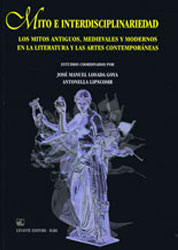

Mito e interdisciplinariedad. Los mitos antiguos, medievales y modernos en la literatura y las artes contemporáneas, José Manuel Losada Goya & Antonella Lipscomb (eds.), Bari (Italy), Levante Editori, 2013, 458 p. ISBN: 978-88-7949-623-0.
Summary
So far, myth criticism had proceeded to identify myths within the literary and artistic productions of each era or to display the resistance of mythical factors to the diverse trends present in literary and artistic movements. The focus was generally limited to a single mode of expression: literary or artistic.
Nowadays, however, myths are characterized by the use of a multitude of media, each of which has traditionally been studied from a single discipline. The aim of this study is to decipher the reasons for this versatility of the myth and its interdisciplinary use. This will enable us to understand much of the postmodernist writing and the culture of our society.
Table of Contents and Introduction
Reviews
- Mayron Estefan Cantillo Lucuara. Revista de Filología Inglesa (Valladolid), 35, 2015, p. 185-190.
- Luis Díaz Viana. Ínsula (Madrid-Barcelona), LXX-819 (2015), p. 23-25.
- Luis Unceta Gómez. Minerva (Madrid), 28 (2015), p. 413-417,
- María Ángeles Chaparro. Cuadernos de Información y Comunicación (Madrid), 20 (2015), p. 183-199.
(https://revistas.ucm.es/index.php/CIYC/issue/current). - Carlos Villanueva García. Hermes. Revista del Mundo Clásico (Madrid), 17 (April 2014), p. 47.
(https://sites.google.com/site/hermesrevistadelmundoclasico/home). - Ana Isabel Jiménez San Cristóbal, ’Ilu. Revista de Ciencias de las Religiones (Madrid), 19 (2014), 333-334.
- Affatato, Rosa, Amaltea. Revista de Mitocrítica (Madrid), 6 (2014), p. 387-394. (pdf)
- Carlos Sánchez Pérez, Revista de Hispanismo Filosófico (Madrid), 19 (2014), p. 254-258.
- Marian Chaparro, Revista de Literatura (Madrid), 76, 151 (January-June 2014), 367-369.
- Aurélie Renaud, Thélème (Madrid), 29, 2 (2014), p. 419-420.
- José Sarzi Amade y Leonor Taiano Campoverde, Mito. Revista Cultural, nº 8 (11 Mar 2014).
- Navi Rodríguez, “Mitocrítica: cómo se refleja un mito en el arte”, Esfinge, Nueva época, 19 Apr(2014), p. 10-14. (pdf)
- Felice Laudadio, Contrappunti (Italy), 8 Feb (2014).
- Por Arte de Blog. Espacio virtual de la Biblioteca de la Facultad de Bellas Artes.
- Vittorio Polito, Giornale di Puglia (Italia), 9 Oct (2013).


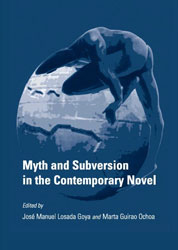

Myth and Subversion in the Contemporary Novel, José Manuel Losada Goya & Marta Guirao Ochoa (eds.), Newcastle upon Tyne, Cambridge Scholars Publishing, 2012, 510 p. ISBN: 1-4438-3746-6.
Summary
This bilingual work aims to identify and explain the subversive rewriting of ancient, medieval and modern myths in contemporary novels.
The book opens with two theoretical essays on the subject of subversive tendencies and myth reinvention in the contemporary novel. From there, it moves on to the analysis of essential texts. Firstly, classical myths in works by authors such as André Gide, Thomas Pynchon, Julio Cortázar, Italo Calvino or Christa Wolf (For instance, Theseus, Oedipus or Medea) are discussed. Then, myths of biblical origin –such as the Flood or the Golem– are revisited in the work of Giorgio Bassani, Julian Barnes and Cytnthia Ozick. A further section is concerned with the lace of modern myths (Faust, the ghost, Ophelia…) in the fiction of Günter Grass, Paul Auster, or Clara Janés. The contributors have also delved into the relationship between myth and art –specially in the discourse of contemporary advertising, painting and cinema– and myth’s intercultural dimensions: hybridity in the Latin American novels of Augusto Roa Bastos and Carlos Fuentes, and in the Hindu-themed novels of Bharati Mukherjee.
This volume emerges form the careful selection of 37 essays out of over 200 which were put forward by outstanding scholars from 25 different countries for the Madrid International Conference on Myth and Subversion (March 2011).


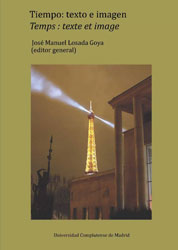

Tiempo: texto e imagen. Temps: texte et image, José Manuel Losada Goya (ed.), Madrid, Universidad Complutense, 2011, 1194 p. ISBN: 978-84-96701-37-3
Summary
This volume combines a reflection on the phenomenon of temporality, with an openness to transversality and interculturality in French and Francophone studies. The studies contained in this book adhere to the following general thematic lines:
- Time, from the perspective of textual linguistics, pragmatics, and psycholinguistics. Diachronic study of the French verbal system: towards an understanding of the contemporary verbal system. Contrastive grammar of different verbal systems. Phraseology and paremiology.
- Times in fiction: literature and other aesthetic manifestations in the French and Francophone sphere. Interrelations among the multiplicity of treatments of time that the very essence of fiction produces.
- The didactics of temporality in F.L.E. (French as a foreign language) and other types of teaching: T.I.C. (computing and communicative technologies) and strategies of teaching-learning.
- Translating time: challenges and impossibilities. Translation of temporality in different idioms and media (literary text, journalistic text, cinematographic text, comic, photograph, videogame, software localization, etc.).
- Interdisciplinary and intercultural dialogues: the treatment of temporality in French and Francophone society and culture, from the perspective of the social sciences and humanities.


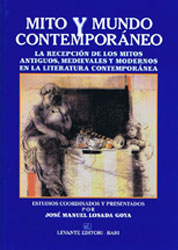

* Awarded the International Prize Giovi-Cittá di Salerno 2011, granted by the Demoetnoanthropologic Association “I Castellani” and the Italian Senate
Mito y mundo contemporáneo. La recepción de los mitos antiguos, medievales y modernos en la literatura contemporánea, José Manuel Losada Goya (ed.), Bari (Italy), Levante Editori, 2010, 785 p. ISBN: 978-88-7949-547-9.
Summary
This volume brings together studies on the theory of myth and its reception in Contemporary Western literature. The theoretical works address myths from many different perspectives: German Romantic Idealism, Psychoanalysis, Structuralism, Philosophy and religious Anthropology. The studies on reception cover Ancient, Medieval and Modern myths in Contemporary novel, poetry and theatre of Europe and America. Three theoretical studies on Greek, Medieval and Modern mythology frame practical questions regarding reception. The myths of the Greco-Roman Antiquity include gods (Ceres), cyclops (Polyphemus), titans (Prometheus), humans of hybrid ancestry (Dionysus, Narcissus, Aeneas), royal blood humans (Orestes, Electra, Antigone, Ariadne Ulysses, Penelope) and other heroes as Philoctetes. The Medieval myths include Celtic myths (the Grail, Cuchulain, Fionn mac Cumhaill, Bran), Germanic myths (the Nibelung) and authentic recreations, such as Ana M. Matute’s. Modern myths are very varied: from Frankenstein and vampires to new cities (Berlin and New York) or recreations of historical characters.
Selected reviews
- Felice Laudadio, Contrappunti, Feb (2012): 10.
- Vittorio Polito, Giornale di Puglia, Jan (2012).
- Rocío Peñalta Catalán, Revista de Filología Románica (Madrid), 28 (2011): 227-228.
- Juan Herrero Cecilia, Thélème. Revista Complutense de Estudios Franceses, 26 (2011): 341-344 (1st part) & 27 (2012): 411-416 (2nd part).
- Vittorio Polito, “Le leggende nel mondo contemporaneo”, Barisera (Bari, Italy), 14.06 (2010): 22.
- José Manuel Estévez-Saá, “Los grandes mitos de la historia a través de la literatura contemporánea”, El Correo Gallego (A Coruña), 1.07 (2010).
- Borja Mozo, Amaltea, revista de mitocrítica (Madrid), 2 (2010): 209-210.


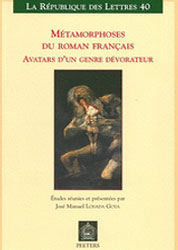

Métamorphoses du roman français. Avatars d’un genre dévorateur, José Manuel Losada Goya (ed.), Lovaina (Belgium), Peeters, 2010, 314 p. ISBN: 978-90-429-2201-3.
Summary
Since its creation, the novel has undergone continual and diverse metamorphoses. From the Breton romances of Chrétien follow, at the beginning of the fifteenth century, innovative texts such as Ysaÿe le Triste. Novels of the Renaissance period distance themselves from the concepts of truth and falsity, announcing the arrival of Pre-Modern poetics (Merlin, Baldus, Les Angoysses douloureuses, Alectoris, Heptaméron). From J.-P. Camus to L’Abbé Faydit, the view of the novel as an antinomy to religion is consolidated. However, the subjects upon which the reflections and applications of the seventeenth century novel center are different: the ambition of those of exemplary nature (the Scudéry siblings), or the adaptation of styles of characters (Sorel). Facing a possible exhaustion of the genre, new solutions are created in the eighteenth century: the fusion of novels in the structural framework (Challe), the interference between form and content (Voltaire), empirical inflection (Diderot, Laclos), and the need to feel passion (Épinay and her literary circle). In the nineteenth century, the novel attempts more to uncover the true self than to tell a story (Sénancour, Chateaubriand), favors interior monologue (Stendhal), or tries to illustrate the relationship between femininity and autobiography (Sand). Upon modifying the novel, representation is modified as well: there is a change of perspective in the observer (Hugo) and the value of plot diminishes regarding that of environment (Zola). Finally, the twentieth century offers various approaches that are difficult to unify: the Proustian projection of nature that is at once classical and innovative, the balance between intimate experiences and the rhythmic fabric of words (Giono, Butor), the imbrication between writing and feminism (A. Ernaux), the influence of news and current events (Besson, Jonquet), the living symbiosis of cultures (Cheng), or, finally, the paradox of trying to delimit protest movements like those of 1968.
Reviews
- Lucien Nouis, Eighteenth-Century Fiction (Hamilton, Ontario, Canada), 24, 4 (2012): 738-740.
- Jean Claude Abada Medjo, Le français à l’université, 16.03 (2011).
- Sarah Lacoste, Fabula (Logroño), 23.03 (2010).


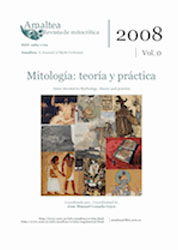

Mitología: Teoría y práctica, José Manuel Losada Goya (coord.), Amaltea. Revista de Mitocrítica (Madrid), nº 0 (2008), 303 p. ISSN: 1989-1709.
Summary
15 articles devoted to theoretical aspects of Myth Criticism and the study of the presence of Classical myths in the Contemporary European literature, from Wilde to Giraudoux and including Stefan George.


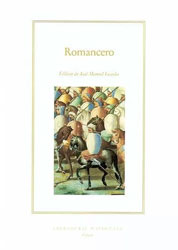

Romancero, traduction et notes de José Manuel Losada, présentation de José Manuel Losada Goya et André Labertit, Paris, Imprimerie Nationale, “La Salamandre”, 2003, 360 p. ISBN: 2-7433-0255-0.
Summary
A collection of mainly anonymous lyric and epic texts, the Romancero reconstructs the destiny of the Spanish nation throughout its history (the vicissitudes of the Muslim invasion, followed by the Christian reply under the banner of El Cid), its legends (the battle between the Spanish nobles and the paladin Roland) and its poetry (enchanting verses intoned by a young peasant woman at the bank of a river). The Romancero suffered wide swings in its reputation: over the centuries, it was considered at times to be a lesson of national history and at other times the receptacle or crucible of the mentality of a nation. For this reason, it was learned and passed on through memorization. The Romancero attained its zenith in the sixteenth century, after which it began a gradual descent to the banks of the Lethe. It was reestablished in the seventeenth century, reclaimed by the great authors of the Siglo de Oro such as Cervantes, Lope, and Calderón. Expelled from the literary sphere of the eighteenth century, the Romancero waited patiently for its rehabilitation, which arrived at the hands of the Romantics, both German (Friedrich Schlegel, Grimm, Goethe) and English (Scott, Byron), and followed later by the French, especially under the patronage of Victor Hugo, the unconditional admirer of this so-called “strange Iliad without any Homer”.
Reviews
- Philippe Lançon, Libération (Paris), 6.05 (2003).
- Jo.S., Le Monde (Paris), 4.06 (2003).
- Michel Stanesco, Cahiers de Civilisation Médiévale (Poitiers), 50 (2007): 86-87.


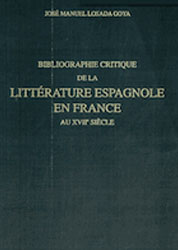

Bibliographie critique de la littérature espagnole en France au XVIIe siècle. Presence et influence, Geneva (Switzerland), Droz, “Travaux du Grand Siècle”, 1999, xxii+671 p. ISBN: 2-600-00313-4.
Summary
The objective of this study is triple: to establish a comparative analysis of the presence of Spanish literature in the French literature of the seventeenth century, to comprehend the profound significance of the evolution of this presence, and to provide the reader with a concrete base about investigation regarding the period between the eighteenth and twentieth centuries. For this reason the book, which dedicates four out of five parts of the text to theoretical, critical, and comparative reflection, inaugurates a new conception of the genre of bibliography. Thanks to a project funded by the Spanish Ministry of Research and other aid, it was possible to use 1150 original editions by 330 authors of the period as well as 750 critical studies, and to establish a profound examination of their reception. A broad introduction, the establishment of all of the editions from the seventeenth century in both Spanish and French, and commentaries of the 517 articles that make up the collection have led to a careful consideration of the problems presented by periodization and the construction of a new theory of the genesis of literary reception.
Selected reviews
- Suzanne Guellouz, Papers on French Seventeenth Century Literature (Paris / Tübingen / Seattle), 28 (2001): 198-201
- Joseph C. Holub, Hispanic Review (Philadelphia, PA), 69 (2001): 265-266.
- Barry Taylor, Bulletin of Hispanic Studies (Glasgow), 72 (2000): 635-636.
- Margaret A. Rees, Modern Language Review (Leeds, England), 95 (2000): 595.
- Daniel-Henri Pageaux, Revue de Littérature Comparée (Paris), 2 (2000): 217.
- Cecilia Rizza, Studi Francesi (Turin), 130 (2000).
- Guy Jucquois, Les Lettres Romanes (Lovaine), 54 (2000): 189.
- Stéphane Macé, XVIIe Siècle (Paris), 52 (2000): 740.
- Daniel Vaillancourt, Recherche Littéraire / Literary Research (Western Ontario, Canada), 31 (1999): 40-44.
- Cristina Sánchez Tallafigo, Dicenda (Madrid), 17 (1999): 405-406.
- Jeffry K. Larson, New Publications of Note – WESS Newsletter (American Library Association), 22 (2), Spring (1999).
- Francisco Capitán, Revista de Literatura (Madrid), 61 (1999): 594-599.
- J. Trethewey & J.P. Short, The Years’s Work in Modern Languages Studies (London) 61 (1999): 122.


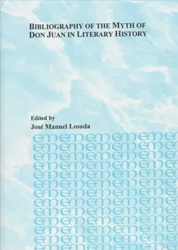

Bibliography of the Myth of Don Juan in Literary History, José Manuel Losada Goya (ed.), The Edwin Mellen Press, Lewiston – Queenston – Lampeter, 1997, xviii+216 p. ISBN: 0-7734-8450-7.
Summary
Often, bibliographies of Don Juan turn into compilations on the theme of the libertine and the seducer: a reference book was needed that compiled solely works that deal exclusively with the myth of Don Juan. A broad introduction affords equally the mythical configuration of the Spanish seducer (who requires a group of women, a dinner party, a transcendent entity, a servant, and a period of defiance) and the malleability of the myth itself (problematic linguistics, geographic overlap, etc.). This bibliography provides a wide range of references under three principal headings: Versions; Critical Studies (books and articles); Translations. It pays particular attention to the significant authors in the field: Tirso de Molina, Molière, Mozart, Byron, Zorrilla, Shaw, etc. It takes account of all the latest artistic and critical works in the fields. The work offers an index of authors at the end.
Reviews
- Wladimir Krysinski, catedrático de literatura comparada de la universidad de Montreal y B.E. Brandt en MellenPress.


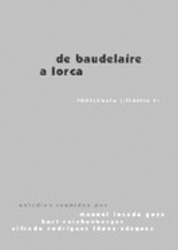

De Baudelaire a Lorca, José Manuel Losada Goya, Kurt Reichenberger and Alfredo Rodríguez López-Vázquez (eds.), Kassel (Germany), Reichenberger, “Problemata Literaria” nº 31-33, 1996, 3 vol., 951 p. ISBN: 3-930700-59-X (vol. I: 3-930700-60-3; vol. II: 3-930700-61-1; vol. III: 3-930700-62-X).
Summary
The book proposes to make a representative sweep of the principal changes that have taken place in the Modern literature between these two emblematic authors: from the morphological point of view, the break with inherited prosody, the rejection of Classical motives; from the ideological point of view, the split from the past, the attraction of the inconclusive and the senseless, of the fragmentation, and of the autonomous conscience.
Reviews
- Janet Pérez, Hispania (Washington), 81 (1998): 312-313.
- Federico Bonaddio, Bulletin of Hispanic Studies (Glasgow), 78 (2001): 284.


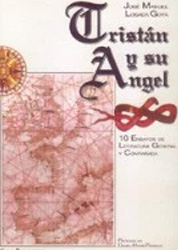

Tristán y su ángel. Diez ensayos de literatura general y comparada, prologue by Daniel-Henri Pageaux, Kassel (Germany), Reichenberger, col. “Problemata Literaria”, 1995, X-188 p.+5 ilustr. ISBN: 3-930700-13-1.
Summary
The work focuses on a series of myths and themes from a comparative perspective with the objective of showing the ideological permeability in several literatures, especially in the reception of Classical literature and in the transmission of the models of writing between French and Spanish literature. Among the myths are that of Tristan (his hypothetical freedom), Venus Cytherea (her presence in various Renaissance collections, and the motives of her absence in others); among the themes, the loneliness of the poet (from the famous “Beatus ille” to the melancholy of Modernity), the concept of purity of blood in novels between the seventeenth and nineteenth centuries (the “cleanliness” of blood in Don Quixote, the anthropological consequences of the fall in Rousseau’s Julie or the New Heloise, the consciousness of the stain on the fallen angel in the Romantic novel). The volume contains a foreword by Daniel-Henri Pageaux, Professor of General and Comparative Literature at the Sorbonne Nouvelle University.
Reviews
- Javier de Navascués, Rilce (Pamplona) 11 (1995): 173-175.


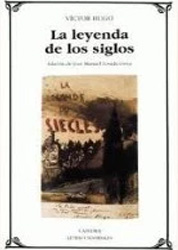

La Leyenda de los siglos (selección de textos), de Víctor Hugo, edited by José Manuel Losada Goya, Madrid, Cátedra, “Letras Universales”, nº 211, 1994, 322 p. ISBN: 84-376-1291-8.
Summary
This translation puts one of Victor Hugo’s fundamental texts in the hands of a wide audience, accompanied by a consistent critical apparatus. This apparatus comprises the introduction, the bibliography and the notes to the text. The introduction is divided into three parts. The first of these undertakes a series of theoretical, anthropological and ethical aspects: the lack of epic poetry in Modern French literature, the yearning of Victor Hugo for continued social progress and his moral compromise on the complete rehabilitation of the dispossessed. The second part advances into the relationship between La Légende des siècles and Spain, with especial emphasis on “Le Romancero du Cid”, “Le Petit Roi de Galice” and “La Rose de l’Infante”. The third part uses genetic analysis with the purpose of making manifest the unity of the whole.
Reviews
- Marta Giné-Janer, L’Ull Crític (Lleida), 3 (1996): 196-197.
- Rafael Gómez Pérez, El Suplemento Semanal (Madrid), 19.03 (1995): 83.


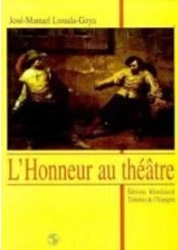

L’Honneur au théâtre. La Conception de l’honneur dans le théâtre espagnol et français du XVIIe siècle, Paris, Klincksieck, 1994, 412 p. ISBN: 2-252-02951-X.
Summary
L’Honneur au théâtre discusses the thematology of honor in the theater of the seventeenth century. The corpus assures the unity of the collection: 21 Spanish pieces and 21 French pieces featuring Spanish stories. The analysis of the plots conduces a general typology of honor: honor based on public opinion, virtue, money, purity of blood. As expected, the French works hardly differ from the Spanish concerning honor based on virtue or money (with exceptions: the status of the poor hidalgo compared to that of the rich gentilhomme). However, there are surprising divergences regarding honor based on public opinion and purity of blood: the conduct of women and the tarnish of impure blood are conceived in a different way in France and this produces a different treatment on stage. The book shows how the Spanish imaginary permeates large sections of the French artistic life.
Reviews
- Michel Philippon, Lettres Actuelles (Mont-de-Marsan), 7-8 (1995): 116.
- Didier Souiller, XVIIe siècle (París), 48 (1996): 193-194.
- Jean-Pierre Leroy, Revue de Littérature Comparée (Paris), 70 (1996): 365-366.


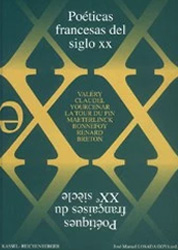

Poéticas francesas del siglo XX. Poétiques françaises du XXe siècle, José Manuel Losada Goya (ed.), preface by Yves Bonnefoy, Kassel (Germany), Reichenberger, col. “Problemata Literaria”, 1994, XIII-217 p.+8 il. ISBN: 3-928064-83-5.
Summary
This book establishes the fundamental lines of poetic production of the twentieth century in French literature through the authors relevant for their creative and theorizing contributions: Valéry, Claudel, Yourcenar, La Tour du Pin, Maeterlinck, Bonnefoy, Renard, Breton. The participation of several contributors (three French professors, one Spanish and one from the United States), as well as the prologue redacted by the afore mentioned Bonnefoy make this book stand out.




Don Juan. Tirso, Molière, Pouchkine, Lenau. Analyses et synthèses sur un mythe littéraire, José Manuel Losada Goya y Pierre Brunel (eds.), Paris, Klincksieck, 1993, 129 p. ISBN: 2-252-02939-0.
Summary
The objective of this compilation of articles is to provide a broad and sturdy base for the study of four texts significant to the myth of Don Juan. It should be marked the quality of the scholars, Full professors of General and Comparative Literature from eight universities. The approaches are varied: Myth Criticism, Hermeneutics, Psychoanalysis, Sociology, Literary History.
Reviews
- Raymond Trousson, Revue de Littérature Comparée (Paris), 70 (1996): 103-104.
